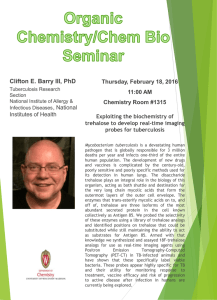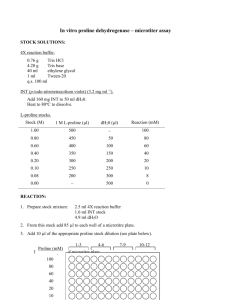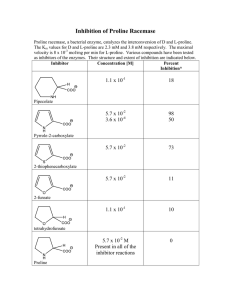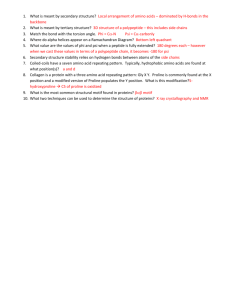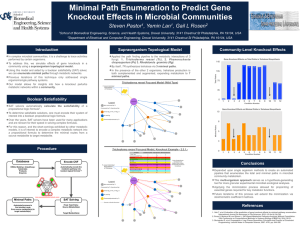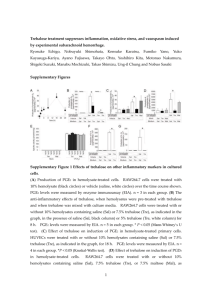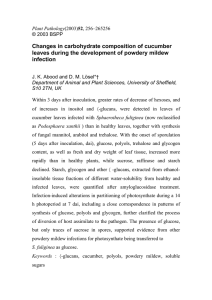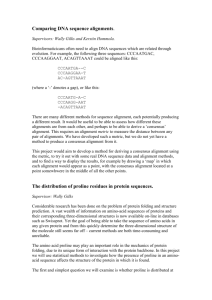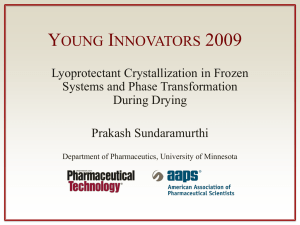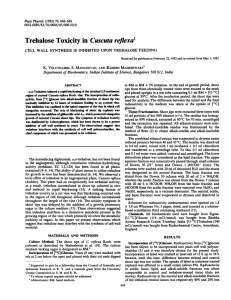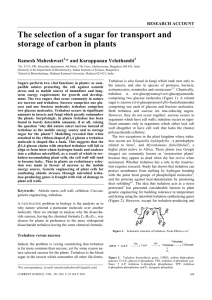Trisha L. Bailey, Dr. Britto P. Nathan, and Dr. Michael... Department of Biological Sciences, Eastern Illinois University, Charleston, IL. Introduction Discussion
advertisement
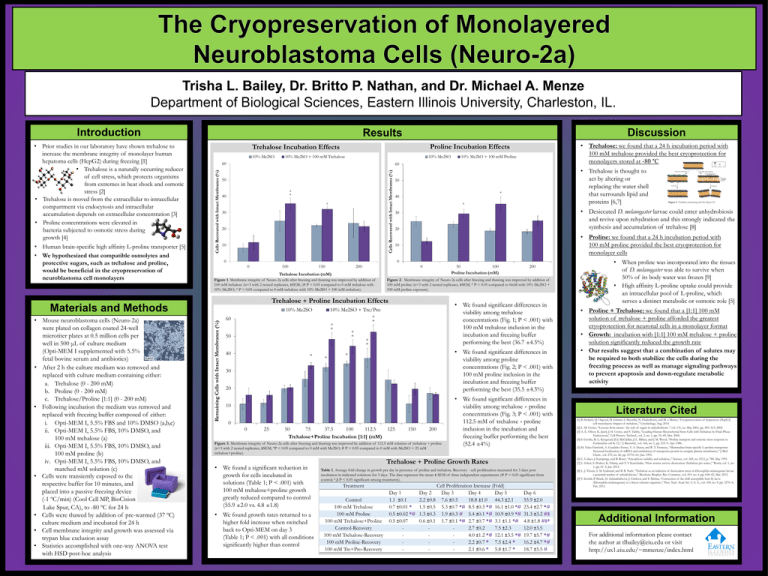
Trisha L. Bailey, Dr. Britto P. Nathan, and Dr. Michael A. Menze Department of Biological Sciences, Eastern Illinois University, Charleston, IL. Introduction 10% Me2SO 10% Me2SO + 100 mM Trehalose 10% Me2SO 60 Cells Recovered with Intact Membranes (%) 50 # * 40 # 30 20 10 • Trehalose is thought to act by altering or replacing the water shell that surrounds lipid and proteins [6,7] 50 * 40 * 0 100 150 20 • Proline: we found that a 24 h incubation period with 100 mM proline provided the best cryoprotection for monolayer cells 10 0 200 50 100 Proline Incubation (mM) Trehalose Incubation (mM) Figure 1. Membrane integrity of Neuro-2a cells after freezing and thawing was improved by addition of 100 mM trehalose (n=3 with 2 nested replicates, ±SEM; (# P < 0.05 compared to 0 mM trehalose with 10% Me2SO; * P < 0.05 compared to 0 mM trehalose with 10% Me2SO + 100 mM trehalose). • We found significant differences in viability among trehalose concentrations (Fig. 1; P < .001) with 100 mM trehalose inclusion in the incubation and freezing buffer performing the best (36.7 ±4.5%) 10% Me2SO + Tre/Pro # 60 * # * # 50 * # * 40 * * • We found significant differences in viability among proline concentrations (Fig. 2; P < .001) with 100 mM proline inclusion in the incubation and freezing buffer performing the best (35.5 ±4.5%) * 30 20 10 0 0 25 50 75 37.5 100 112.5 Trehalose+Proline Incubation [1:1] (mM) 125 150 200 Figure 3. Membrane integrity of Neuro-2a cells after freezing and thawing was improved by addition of 112.5 mM solution of trehalose + proline (n=3 with 2 nested replicates, ±SEM; *P < 0.05 compared to 0 mM with Me2SO; # P < 0.05 compared to 0 mM with Me2SO + 25 mM trehalose+proline). • We found a significant reduction in growth for cells incubated in solutions (Table 1; P < .001) with 100 mM trehalose+proline growth greatly reduced compared to control (55.9 ±2.0 vs. 4.8 ±1.8) • We found growth rates returned to a higher fold increase when switched back to Opti-MEM on day 3 (Table 1; P < .001) with all conditions significantly higher than control 200 Figure 2. Membrane integrity of Neuro-2a cells after freezing and thawing was improved by addition of 100 mM proline (n=3 with 2 nested replicates, ±SEM; * P < 0.05 compared to 0mM with 10% Me2SO + 100 mM proline exposure). Trehalose + Proline Incubation Effects 10% Me2SO • We found significant differences in viability among trehalose + proline concentrations (Fig. 3; P < .001) with 112.5 mM of trehalose + proline inclusion in the incubation and freezing buffer performing the best (52.4 ±4%) Trehalose + Proline Growth Rates Table 1. Average fold change in growth per day in presence of proline and trehalose. Recovery - cell proliferation measured for 3 days post incubation in indicated solutions for 3 days. The data represent the mean ± SEM of three independent experiments (# P < 0.05 significant from control; *,$ P < 0.05 significant among treatments). Treatment Control 100 mM Trehalose 100 mM Proline 100 mM Trehalose+Proline Control-Recovery 100 mM Trehalose-Recovery 100 mM Proline-Recovery 100 mM Tre+Pro-Recovery Figure 3. Trehalose interacting with the bilayer [7]. • Desiccated D. melanogaster larvae could enter anhydrobiosis and revive upon rehydration and this strongly indicated the synthesis and accumulation of trehalose [8] 30 0 0 Remaining Cells with Intact Membranes (%) 10% Me2SO + 100 mM Proline 60 Materials and Methods • Mouse neuroblastoma cells (Neuro-2a) were plated on collagen coated 24-well microtiter plates at 0.5 million cells per well in 500 μL of culture medium (Opti-MEM I supplemented with 5.5% fetal bovine serum and antibiotics) • After 2 h the culture medium was removed and replaced with culture medium containing either: a. Trehalose (0 - 200 mM) b. Proline (0 - 200 mM) c. Trehalose/Proline [1:1] (0 - 200 mM) • Following incubation the medium was removed and replaced with freezing buffer composed of either: i. Opti-MEM I, 5.5% FBS and 10% DMSO (a,b,c) ii. Opti-MEM I, 5.5% FBS, 10% DMSO, and 100 mM trehalose (a) iii. Opti-MEM I, 5.5% FBS, 10% DMSO, and 100 mM proline (b) iv. Opti-MEM I, 5.5% FBS, 10% DMSO, and matched mM solution (c) • Cells were transiently exposed to the respective buffer for 10 minutes, and placed into a passive freezing device (-1 ºC/min) (Cool Cell MP, BioCision Lake Spur, CA), to -80 ºC for 24 h • Cells were thawed by addition of pre-warmed (37 ºC) culture medium and incubated for 24 h • Cell membrane integrity and growth was assessed via trypan blue exclusion assay • Statistics accomplished with one-way ANOVA test with HSD post-hoc analysis • Trehalose: we found that a 24 h incubation period with 100 mM trehalose provided the best cryoprotection for monolayers stored at -80 °C Proline Incubation Effects Trehalose Incubation Effects Cells Recovered with Intact Membranes (%) • Prior studies in our laboratory have shown trehalose to increase the membrane integrity of monolayer human hepatoma cells (HepG2) during freezing [1] • Trehalose is a naturally occurring reducer of cell stress, which protects organisms from extremes in heat shock and osmotic stress [2] • Trehalose is moved from the extracellular to intracellular compartment via endocytosis and intracellular accumulation depends on extracellular concentration [3] • Proline concentrations were elevated in bacteria subjected to osmotic stress during growth [4] • Human brain-specific high affinity L-proline transporter [5] • We hypothesized that compatible osmolytes and protective sugars, such as trehalose and proline, would be beneficial in the cryopreservation of neuroblastoma cell monolayers Discussion Results Cell Proliferation Increase (Fold) Day 1 Day 2 Day 3 Day 4 Day 5 1.1 ±0.1 2.2 ±0.8 7.6 ±0.5 18.8 ±1.0 44.3 ±2.1 0.7 ±0.01 * 1.5 ±0.5 5.3 ±0.7 *# 8.5 ±0.3 *# 16.1 ±1.0 *# 0.5 ±0.02 *# 1.3 ±0.3 1.9 ±0.3 # 5.4 ±0.1 *# 10.9 ±0.9 *# 0.5 ±0.07 0.6 ±0.1 1.7 ±0.1 *# 2.7 ±0.7 *# 3.1 ±1.1 *# 2.7 ±0.2 7.5 ±2.3 4.0 ±1.2 *# 12.1 ±3.5 *# 2.2 ±0.7 * 7.5 ±2.4 * 2.1 ±0.6 * 5.8 ±1.7 * Day 6 55.9 ±2.0 23.4 ±2.7 *# 31.3 ±3.2 #$ 4.8 ±1.8 #$* 12.0 ±3.5 19.7 ±5.7 *# 16.2 ±4.7 *# 18.7 ±5.5 # • When proline was incorporated into the tissues of D. melanogaster was able to survive when 50% of its body water was frozen [9] • High affinity L-proline uptake could provide an intracellular pool of L-proline, which serves a distinct metabolic or osmotic role [5] • Proline + Trehalose: we found that a [1:1] 100 mM solution of trehalose + proline afforded the greatest cryoprotection for neuronal cells in a monolayer format • Growth: incubation with [1:1] 100 mM trehalose + proline solution significantly reduced the growth rate • Our results suggest that a combination of solutes may be required to both stabilize the cells during the freezing process as well as manage signaling pathways to prevent apoptosis and down-regulate metabolic activity Literature Cited [1] B. Stokich, Q. Osgood, D. Grimm, S. Moorthy, N. Chakraborty, and M. a Menze, “Cryopreservation of hepatocyte (HepG2) cell monolayers: Impact of trehalose.,” Cryobiology, Aug. 2014. [2] L. M. Crowe, “Lessons from nature : the role of sugars in anhydrobiosis ,” vol. 131, no. May 2001, pp. 505–513, 2002. [3] A. E. Oliver, K. Jamil, J. H. Crowe, and F. Tablin, “Loading Human Mesenchymal Stem Cells with Trehalose by Fluid-Phase Endocytosis,” Cell Preserv. Technol., vol. 2, no. 1, pp. 35–49, Mar. 2004. [4] S. Grothe, R. L. Krogsrud, D. J. McClellan, J. L. Milner, and J. M. Wood, “Proline transport and osmotic stress response in Escherichia coli K-12.,” J. Bacteriol., vol. 166, no. 1, pp. 253–9, Apr. 1986. [5] M. Velaz-Faircloth, A. Guadaño-Ferraz, V. A. Henzi, and R. T. Fremeau, “Mammalian brain-specific L-proline transporter. Neuronal localization of mRNA and enrichment of transporter protein in synaptic plasma membranes.,” J. Biol. Chem., vol. 270, no. 26, pp. 15755–61, Jun. 1995. [6] C. Colaco, J. Kampinga, and B. Roser, “Amorphous stability and trehalose.,” Science, vol. 268, no. 5212, p. 788, May 1995. [7] C. Erkut, S. Penkov, K. Fahmy, and T. V Kurzchalia, “How worms survive desiccation: Trehalose pro water.,” Worm, vol. 1, no. 1, pp. 61–5, Jan. 2012. [8] L. J. Thorat, S. M. Gaikwad, and B. B. Nath, “Trehalose as an indicator of desiccation stress in Drosophila melanogaster larvae: a potential marker of anhydrobiosis.,” Biochem. Biophys. Res. Commun., vol. 419, no. 4, pp. 638–42, Mar. 2012. [9] V. Koštál, P. Šimek, H. Zahradníčková, J. Cimlová, and T. Štětina, “Conversion of the chill susceptible fruit fly larva (Drosophila melanogaster) to a freeze tolerant organism.,” Proc. Natl. Acad. Sci. U. S. A., vol. 109, no. 9, pp. 3270–4, Feb. 2012. Additional Information For additional information please contact the author at tlbailey@eiu.edu or visit http://ux1.eiu.edu/~mmenze/index.html
